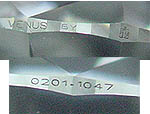- Joined
- Dec 12, 2000
- Messages
- 670
Bob’s Flashes - Girdle Thickness – how important is it? What does faceted girdle mean?
I have received several e-mails from customers with questions regarding girdle thickness.
The girdle is the outside parameter or rim of the diamond which separates the top (crown) from the bottom (pavilion), and is the area where the prongs or the bezel hold the diamond in place in the jewelry piece.
The thickness should not be too thin or too thick which means an ideal thickness would be thin, medium or slightly thick or any combination of these.
An extremely thin girdle would be a girdle so thin that it would be knife edge sharp. If the complete girdle was extremely thin, that would be an accident waiting to happen. In most cases only a very small area of the diamond girdle is extremely thin. If that portion of the girdle that is extremely thin receives a sharp knock it may chip. If you find a diamond that has a girdle range that includes extremely thin, be sure to work with a vendor that can eye ball the diamond and let you know if it poses a problem or not.
If the girdle is too thick as in extremely thick, there would be too much weight of the diamond in the girdle and the diameter of the diamond would smaller than the same weight diamond with a medium girdle. In other words the diamond would appear smaller. An example; if a diamond with a 6.6mm diameter and a 60% depth with a very thin girdle it will weigh about 1.08ct. If it has a very thick girdle it will weigh about 1.18ct. If the girdle thickness is extremely thin and extremely thick the difference will be greater.
The girdle of a well cut diamond is not a constant thickness but fluctuates slightly. That is not to say that it is wavy. A wavy girdle can be observed by looking at the diamond from the side and the girdle appears to wave up and down. The girdle should appear as a straight line that slightly fluctuates in thickness.
Up until about 25 years ago almost all round brilliant cut diamonds had what is called a bruted girdle. It is slightly frosted in appearance and is made from one diamond being held against another diamond that is turning at a fairly high rate of speed in a lath type machine. The diamond is rounded up in this way. If the person doing this operation has a heavy hand this process leaves many hairline feathers extending into the girdle. This is noted as bearding on the Diamond Grading Report.
Many diamonds on the market have bruted girdles and many of them are beautiful with no bearding whatsoever. This is fine. An AGS Ideal cut can have a bearded girdle.
Another type of girdle is a faceted girdle. Instead of a frosted appearance, this girdle has tiny facets around the girdle that have the same appearance as any other facets on a diamond. They are clear and polished. Faceting and polishing takes out any hairline fractures that may have been a result of the rounding up process. It leaves a fresh clean appearance and is preferred by many diamond enthusiasts. The same rules apply to a faceted girdle as to an unfaceted girdle with regards to thickness.
I have received several e-mails from customers with questions regarding girdle thickness.
The girdle is the outside parameter or rim of the diamond which separates the top (crown) from the bottom (pavilion), and is the area where the prongs or the bezel hold the diamond in place in the jewelry piece.
The thickness should not be too thin or too thick which means an ideal thickness would be thin, medium or slightly thick or any combination of these.
An extremely thin girdle would be a girdle so thin that it would be knife edge sharp. If the complete girdle was extremely thin, that would be an accident waiting to happen. In most cases only a very small area of the diamond girdle is extremely thin. If that portion of the girdle that is extremely thin receives a sharp knock it may chip. If you find a diamond that has a girdle range that includes extremely thin, be sure to work with a vendor that can eye ball the diamond and let you know if it poses a problem or not.
If the girdle is too thick as in extremely thick, there would be too much weight of the diamond in the girdle and the diameter of the diamond would smaller than the same weight diamond with a medium girdle. In other words the diamond would appear smaller. An example; if a diamond with a 6.6mm diameter and a 60% depth with a very thin girdle it will weigh about 1.08ct. If it has a very thick girdle it will weigh about 1.18ct. If the girdle thickness is extremely thin and extremely thick the difference will be greater.
The girdle of a well cut diamond is not a constant thickness but fluctuates slightly. That is not to say that it is wavy. A wavy girdle can be observed by looking at the diamond from the side and the girdle appears to wave up and down. The girdle should appear as a straight line that slightly fluctuates in thickness.
Up until about 25 years ago almost all round brilliant cut diamonds had what is called a bruted girdle. It is slightly frosted in appearance and is made from one diamond being held against another diamond that is turning at a fairly high rate of speed in a lath type machine. The diamond is rounded up in this way. If the person doing this operation has a heavy hand this process leaves many hairline feathers extending into the girdle. This is noted as bearding on the Diamond Grading Report.
Many diamonds on the market have bruted girdles and many of them are beautiful with no bearding whatsoever. This is fine. An AGS Ideal cut can have a bearded girdle.
Another type of girdle is a faceted girdle. Instead of a frosted appearance, this girdle has tiny facets around the girdle that have the same appearance as any other facets on a diamond. They are clear and polished. Faceting and polishing takes out any hairline fractures that may have been a result of the rounding up process. It leaves a fresh clean appearance and is preferred by many diamond enthusiasts. The same rules apply to a faceted girdle as to an unfaceted girdle with regards to thickness.









300x240.png)